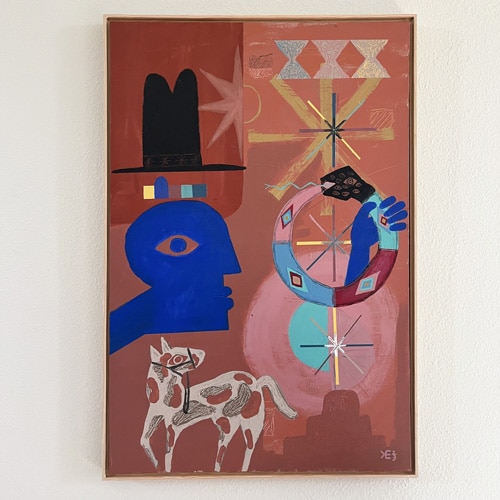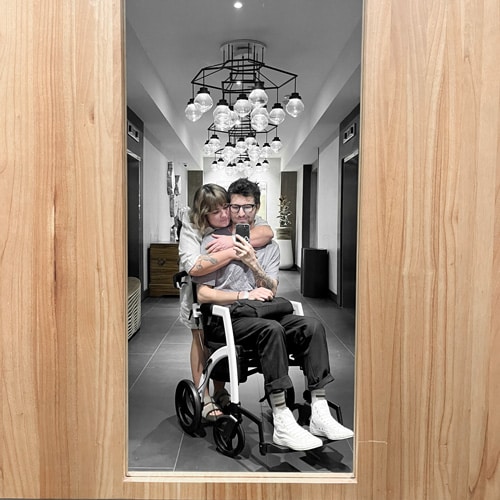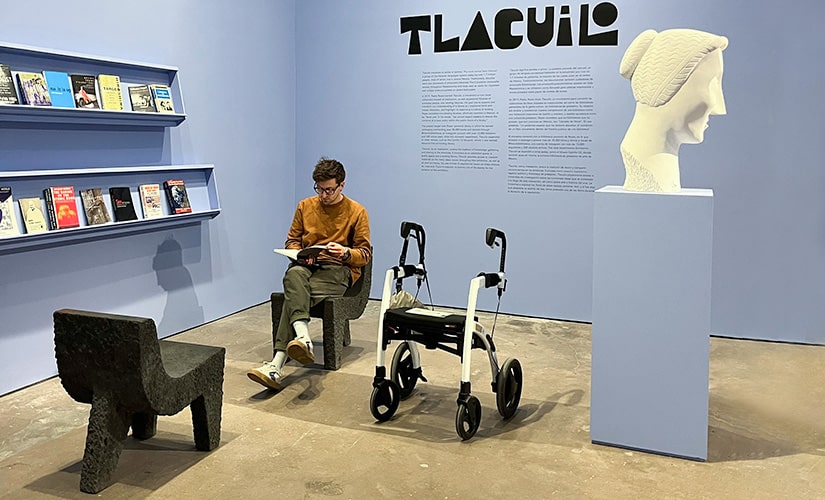Artists are said to perceive the world through different lenses, and it is their vision that ignites their creativity. In art, creativity flourishes when an artist’s vision transcends conventional boundaries, evoking deep emotions and inspiring profound introspection. But where does this distinctive way of perceiving stem from? How does one become an artist? While genetics may play a role for some, for most artists, it is the unfolding of life’s experiences that shapes their artistic journey.
This is also true for Keith Erps, a disabled artist who turned to creative expression when he found himself unable to continue with his passion for physical activities. For Keith, life before disability was very active. From alpine climbing to bikepacking, he had built his life around physical expressions. When symptoms started to create barriers for him, he turned to art, finding a new modality for self-expression.
Explore the Core
In his search, Keith discovered that painting resonated with him on a profound level, sharing a fundamental essence not so dissimilar from mountain pursuits, where feelings of flow and rhythm are naturally occurring.
“I started out messing around with ceramics and trying to engrave on them. I started sketching more often. One day, on the internet, I found someone giving away a painting easel. Painting captured me in a different way”, Keith says.
“However, the appetite for my “old life” is still so real. Disability left me feeling like I just needed to sit certain things out. So, I started boiling things down to their essence, looking for something to adapt to. During this exploration, I realized that it’s not that I miss bouldering, rather I miss violent creativity. It’s not that I miss long-distance cycling, rather I miss perseverance and rhythm. I look to create and recreate these experience through new modalities, none more virtuous than another. The bittersweetness of completing a painting and summitting a mountain aren’t actually worlds apart.”
Just Dandy, You?


Keith’s artwork has something special that captivates viewers, urging contemplation through composition. His artistic expression intertwines exuberance, depicted through joyful colors and shapes, with a sense of gravity conveyed by weighty leitmotifs. Upon closer inspection, one can uncover profound statements within his vision.
“I work under the name “Just Dandy, You?” as a tongue-in-cheek way of dealing with life and acknowledging the absurdity in the world. In my art, I celebrate the myths and symbols that beckon us to look closer.”
This vibrant and enigmatic approach in painting is not only a product of his challenging health journey but also owes some depth to his background in marketing content and philosophical studies. This compelling fusion serves as a resounding affirmation that life is an art form in itself. The manner in which we shape our being inevitably permeates all our endeavors. Despite being relatively new to the world of painters, Keith’s rapid and fervent embrace of artistry undeniably shines through in his remarkable work.
The Aesthetic Factor
As a creative professional and artist, aesthetics hold great significance for Keith. This is one of the main reasons why, when he came across our Rollz rollators. At the moment he needed a mobility aid, he knew instantly that the Rollz Motion was the perfect fit for him.
“I remember viewing the design of the Rollz and realizing that there was something out there that I could use to improve my life without having to make certain concessions on functionality or aesthetics”, Keith recalls.
Even with modern visual appeal, mobility aids remain subject to stigmatization. Keith admits that initially, venturing out with his Rollz Motion proved to be a challenge, influenced both by the discreet glances of others and his own internalized ableism that he had to acknowledge and confront.
“It’s not an easy process the first time, even the first couple times. But, it does get easier. Not because people stop acting silly, they continue doing that. You begin to unravel your own assumptions and internalized ableism. Being super mindful of all the things you can now enjoy with the increase to your access allows you to see the ways mobility aids can add to your life instead of symbolizing some sort of regression.”
Focus on possibilities
 During this process of transition, it becomes important to focus on the new possibilities a mobility aid brings forth, empowering you to fully embrace and enjoy them, rather than dwelling on what might seem diminished. While undoubtedly a challenge, the journey toward reclaiming and cherishing independence can be taken one step at a time.
During this process of transition, it becomes important to focus on the new possibilities a mobility aid brings forth, empowering you to fully embrace and enjoy them, rather than dwelling on what might seem diminished. While undoubtedly a challenge, the journey toward reclaiming and cherishing independence can be taken one step at a time.
“Now I use my Rollz daily along with other aids. Especially at home, I often use it as a rolling bench to help me conserve my energy during ADLs (Activities of Daily Living). But whether we use it right out our door or pack it up for a big trip, my Rollz allows me to stay more present and actually enjoy our outings. Things like independent travel are now available to me again, for work or play.”
Where adaptation takes center stage, the support of loved ones undoubtedly plays a pivotal role in embracing the incorporation of mobility aids into one’s life.
“I received a lot of support from friends and family. I’m always grateful for how many folks in my circle have offered to push the chair.”
Each day presents its own unique canvas, ready to be painted with the hues of our experiences and emotions. On challenging days, he turns to what he calls “violent joy” as his remedy. His resounding takeaway is this: “The most joyful people aren’t the ones with the most joy in their life. They’re the ones willing to go through. So be kinder! When you are faced with the choice to either treat yourself as your best friend or your worst enemy, choose to be kind to yourself. We’re all simply trying to deal with life on this big blue space rock.”
Read more blogs:
